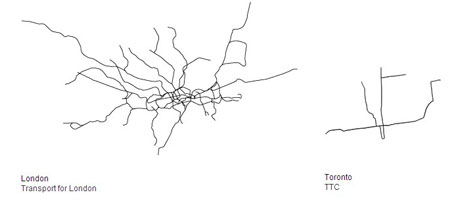
Like Toronto, most of the great cities around the world have a subway system to connect people to key destinations and get people where they need to go faster, without relying on a personal vehicle. So how does ours compare in terms of vastness and complexity? At fakeisthenewreal.org, we found a really neat and simple linear illustration of 36 different subways systems, from Toronto to Tokyo and beyond, all shown on the same scale.
While cities such as London, Moscow, New York and Seoul all have subway systems that are both vast and complex, the ones in some cities tend to be one or the other. For instance, in San Francisco, Washington DC and Los Angeles, the subway systems are vast but not very complex. On the other hand, in Tokyo, Paris and Madrid, they are complex but not very vast. Then, of course, there are subway systems in some other cities that are neither.
So where does Toronto’s current subway system fit in? Ours is similar to those found in cities such at Athens and Delhi. It’s neither vast nor complex and consists of only a few lines covering a relatively small area.
Fortunately, the vastness of our subway system will dramatically improve with the subway extensions that are part of the vivaNext plan. They include the Spadina subway extension that will extend north-west 8.6 kilometres from Downsview Station in Toronto to the Vaughan Corporate Centre in Vaughan, and the Yonge subway extension that will extend north 6.8 kilometres from Finch Station in Toronto to the Langstaff/Richmond Hill Centre by Highway 7. Both of these subway extensions will further connect with vivaNext’s new east-west Highway 7 rapidway that will extend from Highway 50 in Vaughan to Reesor Road in Markham.
